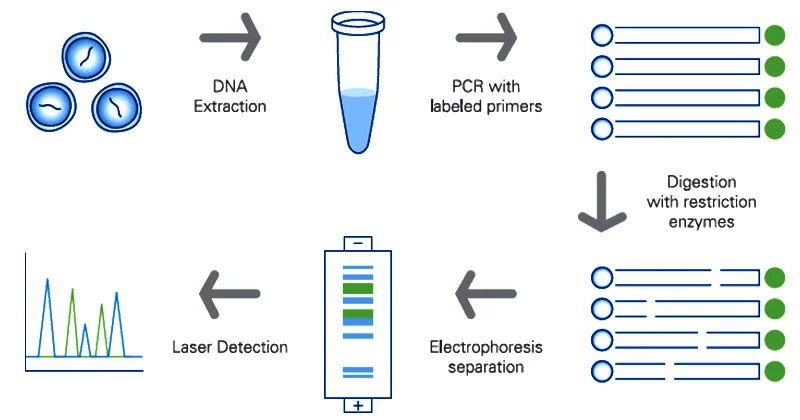Molecular Markers
Molecular markers have revolutionized the field of genetics and have been used extensively in various applications such as genome mapping, plant breeding, forensic analysis, and evolutionary studies. A molecular marker is a DNA sequence or variation that can be detected and analyzed in the laboratory, providing a valuable tool for understanding the genetic makeup of organisms. In crop improvement programs. These markers are DNA sequences that can be used to identify genetic variations and their associated traits. They are valuable tools for plant breeders who want to develop new cultivars that exhibit specific genetic traits that are desirable for agriculture.
Different Types of Molecular Markers
There are several types of molecular markers, including Restriction Fragment Length Polymorphism (RFLP), Amplified Fragment Length Polymorphism (AFLP), Simple Sequence Repeats (SSRs), Single Nucleotide Polymorphism (SNP), and more recently, CRISPR-Cas9 gene editing.
Restriction Fragment Length Polymorphism (RFLP)
RFLP stands for Restriction Fragment Length Polymorphism. It is a technique used in molecular biology to analyze variations in DNA sequences. The technique uses restriction enzymes to cut DNA at specific locations, producing fragments of varying lengths. The resulting fragments are separated by gel electrophoresis and visualized to determine genetic variations among individuals. RFLP analysis has been widely used in forensics, paternity testing, and genetic mapping. However, due to the advancement of technology, other newer and more efficient methods such as Polymerase chain reaction (PCR) have replaced it in many applications.

Amplified Fragment Length Polymorphism (AFLP)
AFLP markers are generated by PCR amplification of random fragments of the genome. These markers are based on the detection of variations in the length of fragments produced by restriction enzyme digestion and are highly informative. AFLP markers have been used in a variety of plant species and are particularly useful for studying genetic diversity, estimating genetic relatedness, and mapping quantitative trait loci (QTL).
Simple Sequence Repeats (SSRs)
SSRs, also known as microsatellites, are tandemly repeated short DNA sequences that are found throughout the genome. These markers are highly polymorphic and have a high degree of reproducibility. SSR markers have been widely used in genetic diversity analysis, mapping of QTLs, and marker-assisted selection.
Single Nucleotide Polymorphism (SNP)
SNP markers are the most abundant type of DNA variation in the genome and occur when a single nucleotide base pair is different among individuals. These markers have been used extensively in genome-wide association studies (GWAS), linkage mapping, and crop improvement programs.
CRISPR-Cas9 Gene Editing
CRISPR-Cas9 gene editing is a relatively new technique that allows researchers to make precise changes to the DNA sequence of an organism. This technique has been used in crop improvement programs to modify traits such as disease resistance, yield, and quality. One of the advantages of CRISPR-Cas9 gene editing is that it can be used to make changes to a specific location in the genome, making it a powerful tool for trait improvement.
Applications of Molecular Markers in Genetics and Crop Improvement
Genetic Diversity Analysis
One of the primary applications of molecular markers is the analysis of genetic diversity within a population. Genetic diversity analysis can help breeders identify new sources of genetic variation that can be used to improve crops. Molecular markers have been used to study the genetic diversity of a wide range of crops, including rice, maize, wheat, and soybeans.
Mapping of Quantitative Trait Loci (QTL)
QTL mapping is a technique used to identify regions of the genome that are associated with specific traits of interest, such as yield, disease resistance, or fruit quality. Once QTLs have been identified, breeders can develop markers that are linked to those regions and use those markers in breeding programs to select for the desired traits.
Marker-assisted Selection (MAS)
MAS is a breeding technique that involves using molecular markers to select for a specific trait of interest. MAS can be used to improve the efficiency and accuracy of breeding programs by allowing breeders to select for a specific trait without having to wait for the phenotype to be expressed.
Gene Editing
Gene editing techniques such as CRISPR-Cas9 have been used in crop improvement programs to modify a specific gene or set of genes associated with specific traits. These techniques have the potential to accelerate the breeding process by allowing breeders to introduce new traits into crops quickly and efficiently.
Challenges in Using Molecular Markers for Crop Improvement
Despite the many benefits of molecular markers, there are some challenges associated with their use in crop improvement programs. Some of these challenges include:
1. Cost: Developing molecular markers can be expensive, particularly for crops that have not been the subject of extensive genetic research.
2. Limited Genetic Diversity: Many crops have limited genetic diversity, making it difficult to identify new sources of variation that can be used in breeding programs.
3. Regulatory Issues: The use of gene editing techniques in crop improvement programs may be subject to regulatory approval, which can create uncertainty and delay the introduction of new traits into crops.
4. Ethical Concerns: The use of gene editing techniques may raise ethical concerns among consumers and policymakers, which may limit their widespread adoption.
Conclusion
Molecular markers have revolutionized the field of genetics and have become essential tools for crop improvement programs. These markers have been used to improve crops by identifying new sources of genetic variation, mapping QTLs, and selecting for specific traits. Despite the challenges associated with their use, molecular markers have the potential to accelerate the breeding process and help breeders develop crops that are more productive, more nutritious, and more resistant to pests and diseases.
